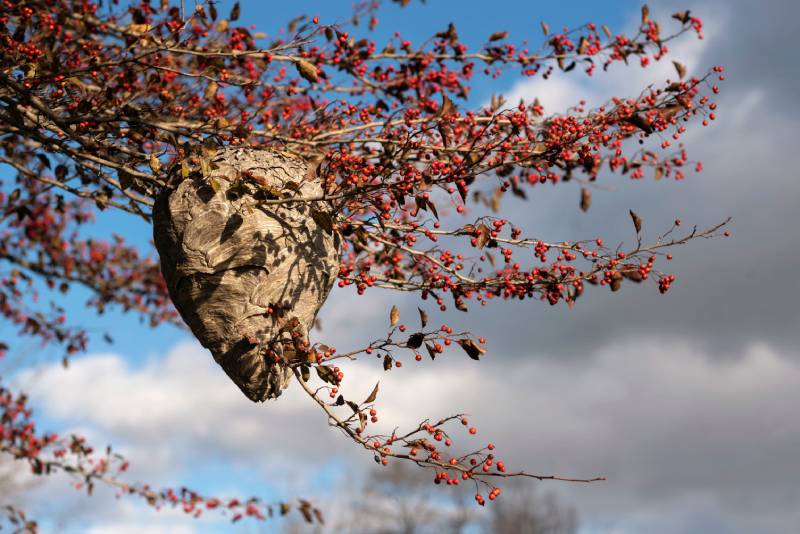Wasps and hornets play an important role in our area’s ecosystem. To put it simply, they prey on and eat a variety of pest insects. That can make things a little more pleasant for all of us.
Even with that in mind, there’s no reason to tolerate wasps and hornets near or in your home or business. There are plenty of other potential nest sites for wasps, hornets, and yellow jackets.
These stinging insects can be a painful and annoying problem at best. A sting in the wrong place, or anywhere on someone allergic to these insects, can cause a real medical emergency.
So, how can you get rid of wasps and hornets near your home or business? It’s possible to do it yourself, although you’ll need to take plenty of precautions to keep yourself safe.
You can also work with knowledgeable pest control professionals, like Wingman. We have the experience and training needed to keep everyone safe and keep wasps and hornets away in the long term.
DIY Tips for Getting Rid of Hornets and Wasps
Staying safe is crucial when it comes to DIY pest control. Protecting yourself from hornets and wasps is especially important, but far from the only safety need to address. You’ll probably have to consider working at dangerous heights, potential chemical exposure, and more.
Above all else, there’s one crucial safety tip to keep in mind. If you’re allergic to hornet or wasp stings, you shouldn’t take on this kind of project by yourself. It’s simply not worth the risk.
Even with full protective equipment, there’s a chance you could still be stung. And one sting is enough to create a medical emergency.
Protecting Yourself from Wasps and Hornets During Treatment

Let’s start with staying safe from wasps and hornets when applying pest control treatments to their nests. Wasps and hornets are more active during the day, and less active at night.
That makes timing incredibly important. Unless you own a full bee suit or similar protective gear, you’ll definitely want to treat nests at night. That reduces the chances of literally stirring up a hornet’s nest and suffering the consequences.
Be sure to cover up and tuck clothes in. Boots, tall socks, pants, long sleeves, facial protection, and eye protection are all crucial.
If you find a nest outdoors in the fall, for example in a tree, you can usually leave it alone. The cold winter weather will do the pest control work for you.
Working at Heights
Many wasps and hornets tend to build their nests in high places. In these cases, you’ll need a ladder to reach the nest and apply treatment.
That means ensuring your ladder is stable before climbing. You also need to follow any specific limitations of the ladder — i.e. weight limits and possibly not using the top step.
There’s always a risk of a swarm of hornets emerging from the nest and frightening or startling you. The last thing you want is for a sting to startle you and cause you to lose your balance.
Working with Pesticides
If you use a pesticide, you need to cover up as much as possible and use old or work clothes. The chemicals can damage many types of fabric.
With pesticides, you have to take your position and the position of the nest into account. It’s not as simple as just spraying the nest. You definitely don’t want the wind to blow the chemicals back into your face or onto your body.
For the same reason, never apply pesticides directly upward. That will also increase your exposure.
Even if you use a soap and water mixture to treat the nest, you’ll still need to effectively cover up. You want to reduce the potential for stings as much as possible.
The Benefits of Professional Hornet and Wasp Removal
Dependable pest control professionals have the necessary protective equipment, tools and treatments, industry knowledge, and practical experience. They know how to safely remove and prevent wasps and hornets in the long term.
At Wingman, our team can treat just about any kind of indoor or outdoor nest. They know how to get rid of wasps and hornets under siding, just as one example.
Across multiple visits, our team will:
- Use electronically calibrated equipment to apply safe and effective liquid and dust treatments to colonies. This takes care of adult insects as well as larvae.
- Following treatment, remove any nests that can reasonably be removed.
- Ensure the liquid and dust treatments fully penetrate any nests in hard-to-reach areas that can’t feasibly be removed.
- Seal gaps and entry points that could be used in the future. This creates a physical barrier that’s one of the very best long-term pest solutions.
Choose Wingman for all of your pest control needs!